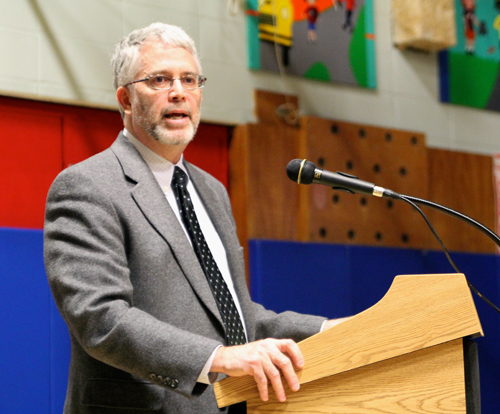Busing changes coming for SWR elementary school students

Beginning next month, school will start 10 minutes later for Shoreham-Wading River elementary school students as administrators try to correct a series of complaints about the district’s new busing system.
The order of bus stops will be reshuffled and parents will start getting notifications of new stop times next week, Superintendent Steven Cohen said.
Mr. Cohen said the district — which reorganized its schools this school year — expected to have some issues with transportation, but not this many. It had added 120 additional stops to an original bus plan to alleviate complaints last year from parents who said bus stops were too far away or located in unsafe areas.
But those extra stops lengthened route times to “unacceptable levels,” Mr. Cohen said, admitting that the district had trouble getting kids to school on time.
“We knew it was happening but we didn’t know how long it would take for the little guys to get on the bus,” he said. To address the issue, the district will push back start and end times at both district elementary schools by 10 minutes.
Tom McEnany, a resident and area manager for the district’s transportation company, First Student, said buses are now driving across the district to pick up students, leading to even longer drive times. He insisted the district’s busing woes would be fixed with the new schedule.
“We will be fine,” he said.
The new busing and school day schedule starts Monday, Oct. 6.
• The Shoreham-Wading River school board is considering shaving a $48.6 million bond proposal into a smaller bond. The move would involve creating a separate proposition to voters that would allow the district to use millions in previously acquired state aid to subsidize the bond.
Board member Michael Fucito said the use of the funds — called “prior year state aid,” and given to the district by the state to offset shortfalls in the aid the district was supposed to receive in previous years — would lower overall interest rates on the bond itself.
If the board does decide to go with a decreased bond amount, it would require two votes: one for the bond and one for the district to pull money from its reserves to pay for the rest of the improvement work, which could include new classrooms, roof repairs and other improvements.
Using prior year state aid wouldn’t result in any immediate tax increase in taxes, district administrators said. However, some members of the district’s bond committee that came up with the original pitch warned against trimming or divvying up the bond.
“Everything is a big ticket item,” said Erin Saunders-Morano. “As you can see, our district is falling to the ground around us … It’s almost a ‘now or never.’”
Board members agreed they wouldn’t discuss what to include in the bond until they see a “line-by-line” listing of construction plans.
Mr. Cohen said a district architect will come up with a roughly $15 million “bundle” proposal next week that would maximize state aid while trimming the bond.








